Hair flap surgery is now considered an outdated method for reversing the signs of hairline recession. Different versions of the procedure include the Juri Flap (Temporoparietal-Occipital Flap), Elliot Flap (Temporoparietal Flap), and Fleming/Meyers Flap Surgery.
The basic technique involves removing a section of the frontal scalp where thinning or hair loss occurs.
The nomenclature for the different hair flap surgeries often refers to specific anatomical regions of the scalp used to create the flap.
- Temporal – around the ears
- Parietal – above the ear area
- Occipital – base of the skull
The American Hair Loss Association names hair flap surgery as number one on their list of procedures to avoid.
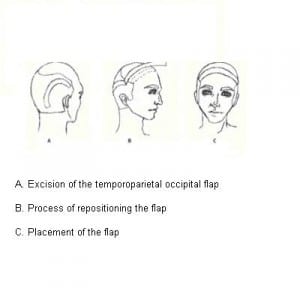
Brief History of Hair Flap Procedures
In its earliest days, flap surgeries corrected scars on the eyebrows and the scalp. During the 1950s, doctors performed hair restoration with large-sized punches that resulted in hair tufts, like on a doll. Due to this unnatural look, flap procedures started to grow in demand around the mid-1970s. The surgeon who led this resurgence was J. Juri from Argentina. Other doctors who became known for developing different hair flap methods include Mayer and Fleming from the United States and Patrick Frechet from France.
Different Types of Hair Flap Surgery
Several variations of flap surgery have emerged for the correction of male pattern baldness in the hairline area.
Juri Flap (Temporoparietal-Occipital Flap Surgery)
Surgeons remove the hair-bearing flap from the temporal, parietal, and occipital regions of the scalp
Elliot Flap (Temporoparietal Flap Surgery)
In this procedure, the hair-bearing flap results from incisions made in the temporal and parietal regions of the scalp.
Fleming/Mayer Flap Surgery
In this procedure, the curved flap is derived from the side of the head. The highlighted aspect of this procedure is creating a “sculpted hairline” versus one that runs straight across the forehead. As such, the sculpted hairline allegedly mimics the irregular contours found in natural hairlines.
The Flemming Meyers flap surgery requires three separate surgeries scheduled a week apart from each other. After each session, the surgeon closes the wounds by sewing the edges together. The patient wears an overnight dressing and can return to work in between their procedures.
In the third surgery, the doctor anchors the flap to form a new hairline along the forehead. In cases of continued hair, the surgeon will create a second flap on the other side of the head and placed it behind the first one. The recommended time frame for the new flap is three months following the initial set of surgeries. Any gaps of baldness that remain in between the two flaps are treated with scalp reduction, removing areas of skin to minimize the area affected by hair loss. However, this incurs further disfigurement. Continued thinning or shedding remains a possibility, creating even more cosmetic problems for the patient.
The Unwanted Consequences of Hair Flap Procedures
Patients who opt for hair flap surgery are usually motivated to achieve a faster resolution of their hairline recession. In theory, the method may sound like a straightforward and viable approach. But in actuality, several forms of permanent deformities arise from the surgery that patients need to be aware of. These include:
Multiple linear scars in unusual areas: These formations occur in the regions where the flap is taken from and where the flap is placed.
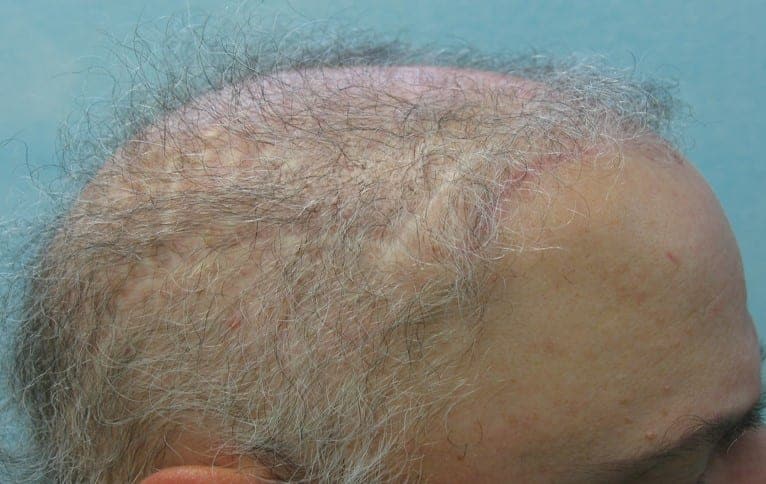
Abnormal hair direction: Hair that grows on the flaps positioned in the frontal/hairline area will point backward. This contradicts what is found in nature, where frontal hairs are directed forward.
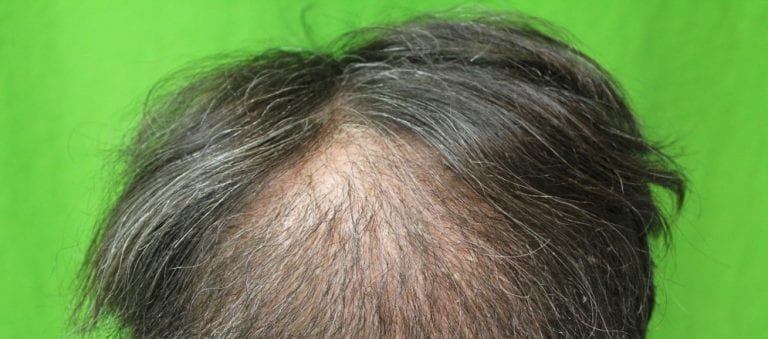
Abnormal hairline: The resulting hairline is not only unnatural looking but also asymmetrical. Furthermore, a conspicuous scar can be stretched, ridged, or depressed and hard to camouflage. The loss of temple points also contributes to the abnormal appearance of the hairline.
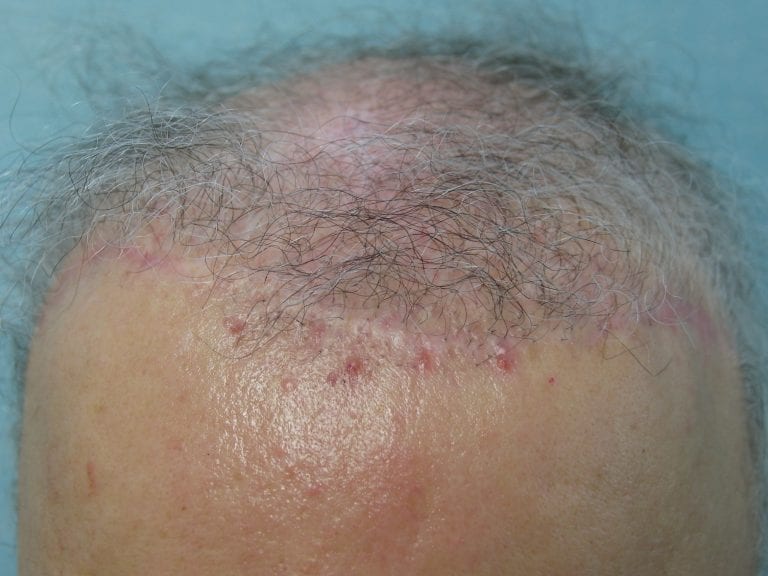

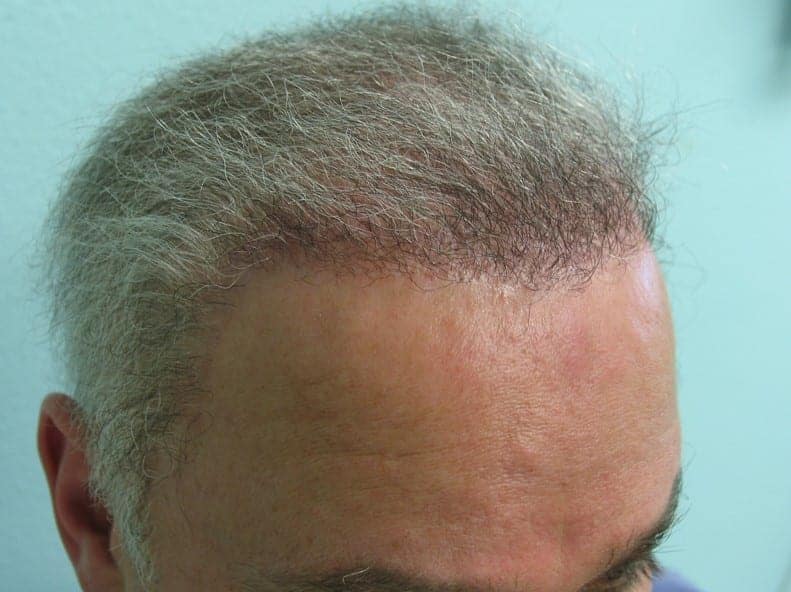
Unnatural hair loss patterns: In most patients, hair loss will continue to progress. The pattern of hair loss that follows flap surgeries will undoubtedly be more unnatural in appearance.
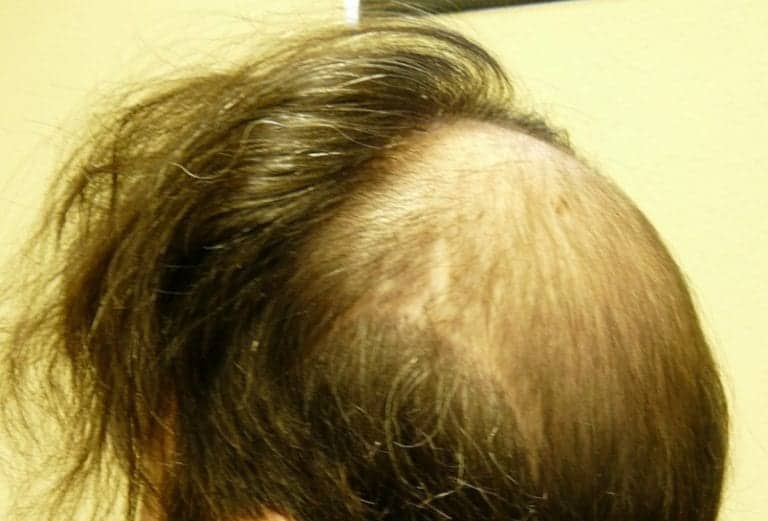
Deformed occipital and nape areas: When the flaps are derived from the occipital (i.e., lowest) areas of the scalp, the occipital and nape areas become deformed and lifted. The posterior and neck hairlines then become thinned and misaligned.
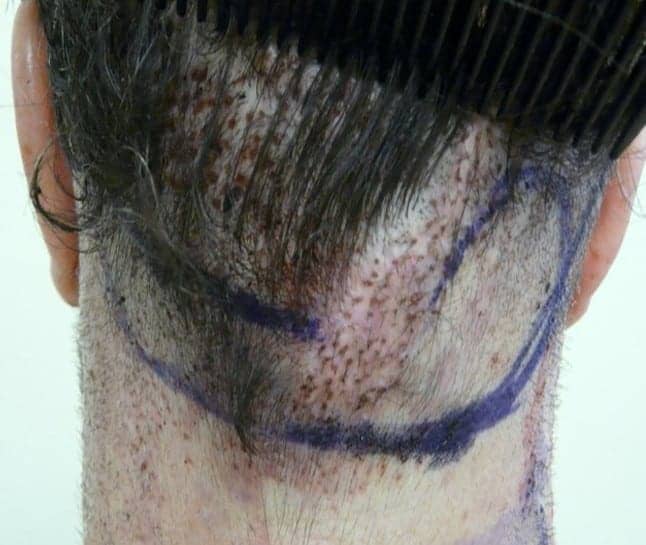
Hair Flap Surgery Repair – Dr. U’s Approach
The actual scarring and scalp distortions from flap surgery are permanent. However, the objective of concealing these results is quite feasible by harvesting and transplanting an abundant quantity of body hair grafts, especially in situations where the scalp supplies of follicular units have been exhausted.
Using advanced FUE tools and protocols, Dr. Umar has helped many patients repair scarring and regain a normal appearance after undergoing invasive scalp altering procedures such as flap surgeries and scalp reductions. If the scalp cannot provide enough follicles to cover the damage left by flap procedures adequately, body hair extractions offer the potential to replenish donor supplies in the right candidates abundantly.
Repair of Abnormal Hairline and Linear Scars in Unusual Areas Resulting From Hair Flap Surgery
Corrections of abnormal hairlines and linear scars in unusual places can be achieved by inserting an appropriate quantity of donor grafts to recreate the hairline temples and hide the scar tissue. In cases where scalp sources have been exhausted, specialized technology such as the Dr.UPunch intelligent ™ to harvest large quantities of healthy, robust body hair follicles to create the desired end coverage.
Repairing Linear Scars and Unnatural Hairline
On this patient, body hair was used to overcome the issues of the abnormal hairline that was created and the linear scars.

Repair of Hair Growth Patterns Arising From Hair Flap Surgery
Hair flap surgery will result in hair (on the repositioned flap) that grows backward on top of the head when the normal growth of hair in these regions actually points forward. In the case of the patient featured below, the normal hair whorl pattern was created by correcting the erroneous hair growth directions, planning out a new hair spiral pattern on the crown, and transplanting body hair grafts according to this planning to achieve the final coverage and results shown below.
These before and after photos depict the outcome of using body hair follicles extracted with the Dr.UPunch Rotor intelligent ™ to produce the coverage needed for this patient’s hair flap surgery repair.

Repair of Hair Growth Patterns Arising From Hair Flap Surgery
Removing and closing the areas of hair loss in the hairline through flap surgery will elevate the nape and occipital areas, as shown below.
The required coverage needed to conceal this permanent deformity can be achieved by harvesting from body donor resources to recreate a normal appearance in these areas.
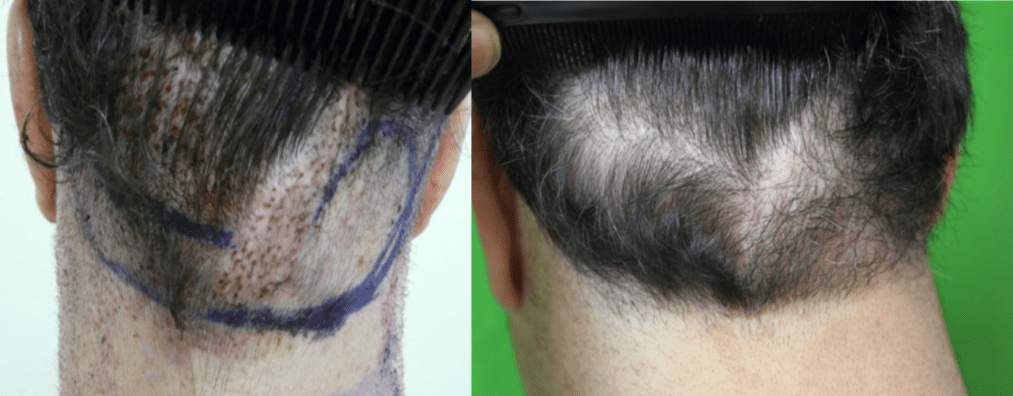
To schedule a complimentary consultation to speak to Dr. Umar about repairing prior hair restoration results at his Los Angeles clinic, schedule an appointment.
Why Does Hair Flap Surgery Still Exist?
Advocates of flap surgery state that this approach offers patients a way to achieve immediate coverage so that they don’t have to endure a three to a four-month waiting period for the first signs of hair growth to appear. There is no temporary loss of hair since the follicles remain in the skin and stay within normal growth cycles.
However, despite the convenience of not having to wait for hair growth, patients will have to sacrifice a normal healthy scalp for permanent disfigurement. They will certainly have multiple scars from the incisions. When the flap is twisted to create a hairline, a knot will form, leaving a permanent deformity on the scalp. Therefore, short haircuts remain out of the question. In the long term, the patient will likely feel that the cons far outweigh the pros of immediate gratification.
There are remote and rare situations where flaps may be useful; these include congenital deformities, trauma, and burns.
Hair Flap Surgery Repair – Patient Images and Video
Many individuals end up regretting their decision to undergo hair restoration using flap surgery. Here is an example of a former Juri flap patient who came to see Dr. Umar repair his unnatural-looking hairline using Follicular Unit Extraction
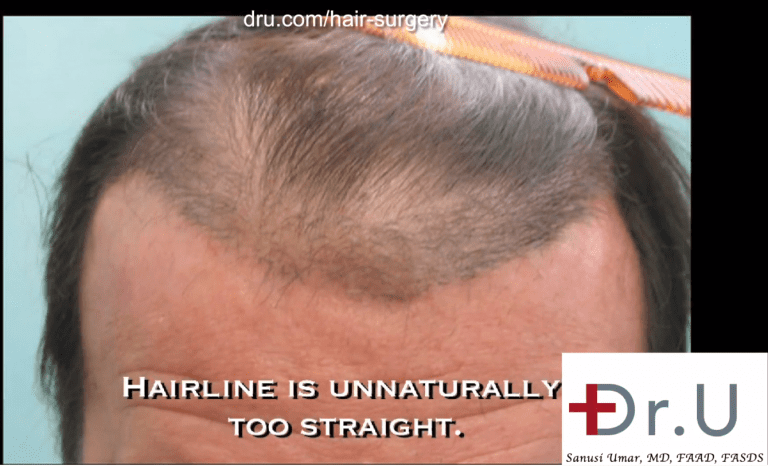
Not only did this individual have an obvious linear scar across his forehead, but his hairline also consisted of a thick row of unnatural hairs that pointed in the opposite direction of growth and limited his styling options.
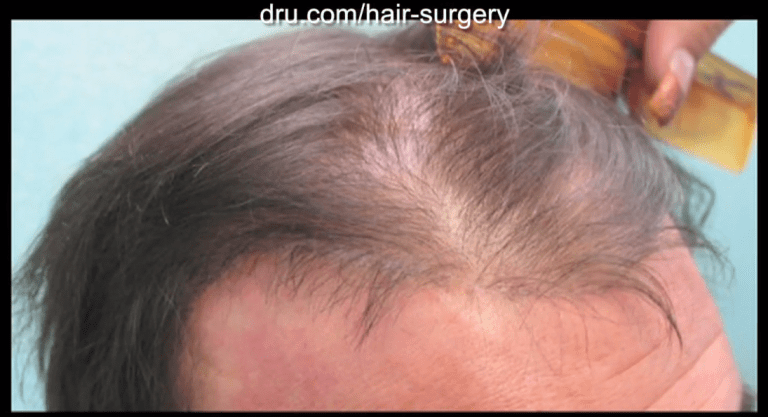
A realistic hairline is characterized by a gradual progression from soft, thinner hairs in the very front to thicker hairs towards the back. Instead, this patient was left with a very sharp line without the soft transitions of a natural-looking hairline. His temples were badly crafted with temporal recesses that were abnormally blunt. Furthermore, the transition from the temples to the hairline appeared exceedingly awkward.
To counter these issues, it was, therefore, necessary to:
- acquire grafts that produce finer quality hairs
- correct the unnatural hair growth patterns in both the hairline and temples
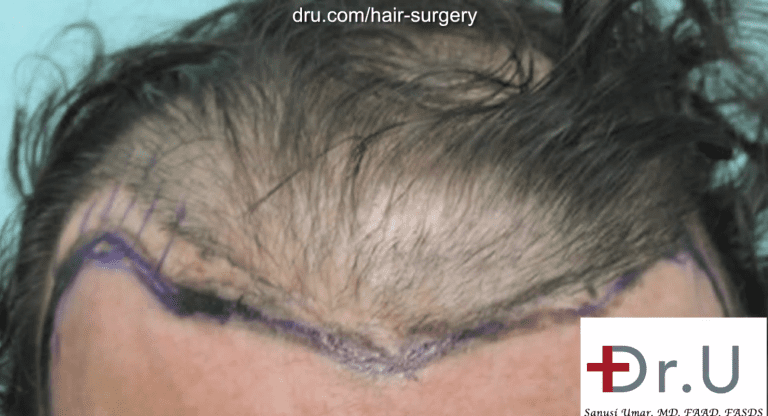
Using his specialized Dr.UPunch Rotor ™ device, Dr. Umar extracted a donor supply of 1500 grafts consisting of nape and head hair follicles.
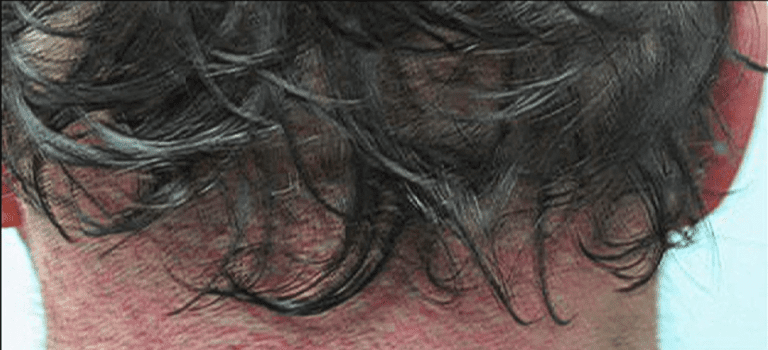
Whereas regular FUE punches are sufficient for extracting regular straight head hair, harvesting other types of hair follicles requires more specialized instruments.
The Dr.UPunch Rotor safely accommodates different hair growth angles that would otherwise lead to damaged grafts with basic FUE rotary punch tools. Furthermore, the patented punch tip of Dr. Umar’s device deliberately creates specific wound configurations that result in far better skin healing results in the donor area. Since the nape is often quite visible, leaving a pristine appearance in this region is an important consideration for the patient’s final results.
Dr. Umar achieved the natural-looking hairline that the patient hoped to achieve by inserting the nape hair grafts into the Juri flap linear forehead scar and correcting the direction of hair growth in the surrounding areas.
Finer nape and head hairs are placed in front of the frontal linear scar by Dr. U to camouflage the scar and create a natural-looking hairline.

Learn more about this patient’s Juri flap repair performed by Dr. Umar by watching this video.
Individuals who are interested in hairline repair from flap surgery can speak to Dr. Umar about their condition by signing up for a free consultation
Complications of Hair Restoration Using Hair Flap Surgery
Flap surgery is an incredibly invasive and disfiguring procedure that can entail serious complications. As discussed above, these operations will leave linear scars as well as incorrect directions of hair growth. Here are some additional risks.
Necrosis
Theoretically, the flap remains attached to the scalp and still maintains a connection to its original blood supply. However, in creating the flap, the surgeon had to sever blood vessels on three sides. Therefore, this loss of blood flow may lead to necrosis (tissue death). The hair follicles residing in the flap would also die, leaving the patient with no hair to cover the flap. And the flap itself would turn into a large and highly exposed scar.
Also, patients with flap surgeries have a higher chance of developing scalp necrosis as a complication following other scalp surgeries in the future.
Permanent Shock Loss
The incisions used to create the flap can traumatize existing hair follicles. In some patients, this will result in temporary thinning or shedding. In others, the hair loss could be permanent.
Frankenstein Forehead
Every patient’s forehead will have a unique slope. In some individuals with an extremely vertical forehead, the placement of the flap may create additional weight in the area, causing a bump to develop with a resemblance to Frankenstein’s forehead.

Despite the convenience of an instant hairline, flap surgery invariably results in permanent disfigurement to the scalp. Many individuals find themselves unhappy with their results, or worse yet, facing unforeseen consequences that require additional medical help. Considering long-term scenarios is always advised over short-term gratification, especially when it comes to major procedures like hair restoration.
Individuals in the Los Angeles area interested in Dr. Umar’s expertise in repairing flap surgery results are invited to sign up for a free consultation.
Frequently Asked Questions – Hair Flap Surgery
Why do doctors still offer hair restoration using invasive and risky hair flap surgery methods?
The American Hair Loss Association cites economics as the reason why flap surgery still exists. Establishments that offer this procedure would need to invest considerable amounts of time and money in replacing their infrastructure with newer practices. This would involve hiring and training technicians and spending several months learning and master more up-to-date hair restoration techniques. Furthermore, hair transplant operations require more time to perform (about 5-10 hours) than flap surgeries. With time equating to money, such overhauls would incur major financial losses. Given that these imperatives are not patient interest-focused, it is in the patient’s interest to do his/her research and avoid clinics that have not evolved beyond the use of hair flap surgeries for hair restoration.
Why would someone undergo hair flap surgery knowing that hair in the hairline points in the opposite direction?
According to providers, some patients value the ability to attain immediate coverage and density. Therefore, they consider inaccuracies in hair growth directions to be something that they or others would not easily notice. This usually is not the case as the egregious problems of hair flap surgery (discussed in this article) are often so very obvious and difficult to conceal. There are rare occasions where flap surgeries may conceivably be considered, such as repairing congenital deformities and burns.
What happens if balding continues after a hair flap surgery?
Certainly, continued hair loss is a major risk for flap surgery patients. In such cases, Follicular Unit Extraction is the recommended technique for repair. Permanent linear scars are a non-issue since tiny punches directly harvest individual follicular unit grafts from the scalp. If hair loss has progressed to the point where there are insufficient head donor grafts, it is possible to acquire large quantities of hair from body regions, such as the beard, chest, back, or stomach, in select candidates.
Have more questions for Dr. Umar? Use this button to submit them:
FURTHER READING
Juri Hair Flap Surgery Problems Fixed By Dr.UGraft FUE Los Angeles
Scalp Reduction and Progressive Hair Loss Before and After Repair by Dr.UGraft in Los Angeles
